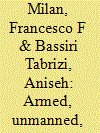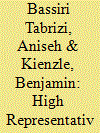|
|
|
Sort Order |
|
|
|
Items / Page
|
|
|
|
|
|
|
| Srl | Item |
| 1 |
ID:
172569


|
|
|
|
|
| Summary/Abstract |
Current dynamics in UCAV proliferation in the Middle East signal that combat drones have become key strategic enablers for state actors in the region, and are no longer seen as an optional asset. With the development of a multitude of indigenous UCAV projects, and the arrival of Chinese-made armed drones on the international market, military procurement in the Middle East has entered a new phase, in which possessing armed drone capabilities is becoming the norm. This article examines the operational and strategic considerations driving Middle Eastern states’ UCAV procurement policies, analysing those countries who have been focusing on armed drones for combat purposes and additional intelligence, surveillance, target acquisition, and reconnaissance (ISTAR) needs. The main drivers behind this trend are the operational and strategic advantages brought about by UCAVs, where the benefits related to cost, reliability, and operational risk mitigation are matched by the increased ability to project power that the platform allows, either through deniability or by making UCAVs available to proxies and allies.
|
|
|
|
|
|
|
|
|
|
|
|
|
|
|
|
| 2 |
ID:
174569


|
|
|
|
|
| Summary/Abstract |
The negotiations with Iran about its nuclear programme have seen the most protracted involvement of the High Representatives of the European Union in a high-profile policy case. This article traces the evolution of the High Representatives’ participation in the negotiations, from the first contacts with the E3 (Germany, France and the United Kingdom) in 2003 to the adoption of the Joint Comprehensive Plan of Action in 2015. It focuses on the institutional role the High Representatives played in relation with the directoires leading the talks with Iran – first the E3 and, since 2006, E3/EU. In this context, it examines the personal and organisational factors that affected the influence each of the three High Representatives (Javier Solana, Catherine Ashton and Federica Mogherini) had in regard to the directoires. The analysis distinguishes specifically between the phases before and after the 2009 Lisbon Treaty. The article shows how similar personal qualities of the three High Representatives in terms of problem-solving and trust-building gave them political capital that enabled them to adopt a fairly constant role as bridge-builders within the directoires and between the directoires and other actors. The reforms of the Lisbon Treaty had only a minor impact.
|
|
|
|
|
|
|
|
|
|
|
|
|
|
|
|
|
|
|
|
|